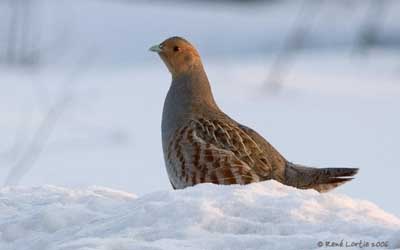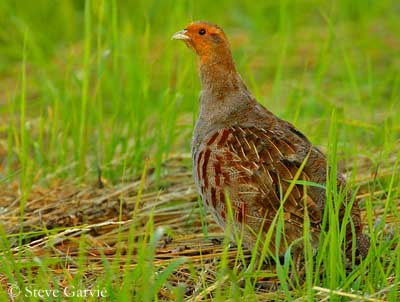
Ang: Grey Partridge
All : Rebhuhn
Esp : Perdiz Pardilla
Ital: Starna
Nd: Patrijs
Sd: Rapphöna
Photographers:
Jean Michel Fenerole
Photos d’Oiseaux du monde
Steve Garvie
RAINBIRDER Photo galleries
René Lortie
http://rlortie.ca
Eugène Montocchio
Galerie Photos Nature
Jean Michel Peers
JMPN PHOTOGRAPHIE
Text by Nicole Bouglouan
Sources:
HANDBOOK OF THE BIRDS OF THE WORLD Vol 2 by Josep del Hoyo-Andrew Elliot-Jordi Sargatal - Lynx Edicions - ISBN: 8487334156
THE HANDBOOK OF BIRD IDENTIFICATION FOR EUROPE AND THE WESTERN PALEARCTIC by Mark Beaman, Steve Madge - C.Helm - ISBN: 0713639601
THE COMPLETE BOOK OF BRITISH BIRDS – Written by “Royal Society for the Protection of Birds” experts - Préface de Magnus Magnusson - Michael Cady- Rob Hume Editors - ISBN: 0749509112
ENCYCLOPEDIE DES OISEAUX DE FRANCE ET D’EUROPE – de Peter Hayman et Rob Hume - Flammarion – ISBN : 2082009920
Hennache, A. & Ottaviani, M. (2011). Cailles, Perdrix et Francolins de l'Ancien Monde, 400 pages. Editions W.P.A. France, Clères, France. ISBN 978-2-9512467-3-7
Hennache, A. & Ottaviani, M. (2005). Monographie des faisans, volume 1. Edition W.P.A. France, Clères, France. ISBN: 2-9512467-1-4
Hennache, A. & Ottaviani, M. (2006). Monographie des faisans, volume 2. Edition W.P.A. France, Clères, France.ISBN: 2-9512467-2-2
"Les auteurs renoncent à leurs droits d'auteurs pour que la vente de cet ouvrage, publié par la World Pheasant Association, soit destinée à soutenir des projets de conservation."
ARKive (Christopher Parsons)
Pájaros de España (JL Beamonte)
Wikipedia, the free encyclopaedia
BirdLife International (BirdLife International)
Grey Partridge
Perdix perdix
Galliforme Order – Phasianidae Family
BIOMETRICS:
Length: 29-31 cm
Wingspan: 45-48 cm
Weight: 310-455 g
DESCRIPTION:
The Grey Partridge is a bird of cultivated areas and a famous gamebird. This species has been introduced to several parts of the world as gamebird, including wide areas of North America and Canada.
The adult is a plump bird. The upperparts are chestnut-brown and grey, but the colour is very variable. The hind neck is grey-brown. The wings are mottled brown and darker brown.

The underparts are grey with dark chestnut patch on the lower breast. The belly is greyish-white. The grey flanks are heavily barred chestnut.
The head is bright chestnut to orange, including chin and throat. The crown and the ear-coverts are grey.
The strong, slightly hooked bill is whitish, typical of Phasianidae species. The eyes are brown, surrounded by narrow, faint, red eye-ring. Legs and feet are pale pinkish-grey, and we can see a spur on the rear of each leg.
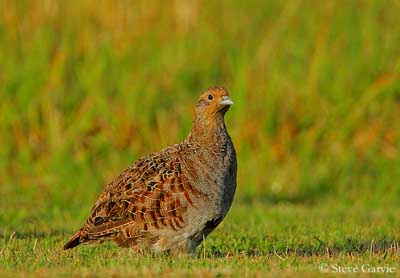
The female is duller overall, and the chestnut breast patch may be absent. She is slightly darker in summer. She has chestnut face but lacks the broad supercilium.
The juvenile is yellow-brown and lacks the face and underpart pattern.
The immature has more conspicuous bars on wings and browner legs.
We can find several subspecies with great variation of plumage. Usually, the western populations are more rufous-brown than the eastern birds which are often paler and greyer.

VOICE: SOUNDS BY XENO-CANTO
The Grey Partridge male gives advertising calls by day and by night, a grating squeak “kierrr-r-r-r-ik”.
When the bird is flushed, it utters a rapid and squeaky alarm call “ker-ik-krrip-krrip-kip-ip-ip…” as it takes off from cover.
HABITAT:
The Grey Partridge frequents cultivated areas, grasslands and steppes in temperate zones. It needs ground cover such as scattered shrubby areas and hedgerows from where it flushes when disturbed. This species is a bird of the open areas, but it has adapted to the changes for agriculture expansion.
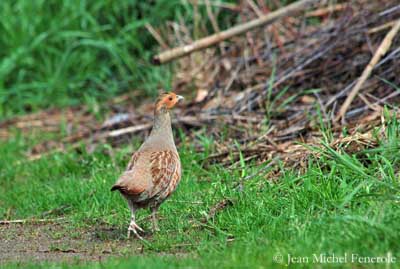

RANGE:
The Grey Partridge breeds across most of Europe into W Asia. It has been introduced in North America and Canada where it is common, mainly in S Canada and N USA.
BEHAVIOUR:
The Grey Partridge feeds on plant matter such as seeds of weeds and cereals, and grass leaves. It also catches insects. In autumn, it feeds mainly on vegetal items. The chicks are fed with insects during the first two weeks.
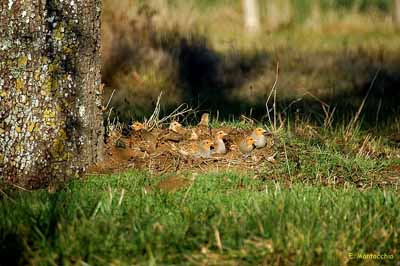
The Grey Partridge can be territorial but it does not defend the boundaries. They live in groups during several months, including family parties or “coveys” and some non-breeding adults, and even two families may gather together. These coveys appear to be sedentary in winter according to the weather conditions and the food availability.
These coveys disperse in early spring and pairs form.
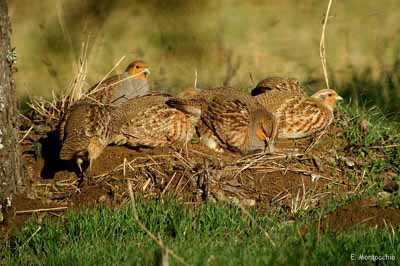
During the courtship displays, the male spread wings and tail in order to expose the rich plumage pattern, and the conspicuous barred flanks are displayed too. Both mates perform soft movements and rub their head and neck, and mutual billing can be observed. Some chases occur between them too.
Copulation, displays, nesting and feeding take place within the territory.
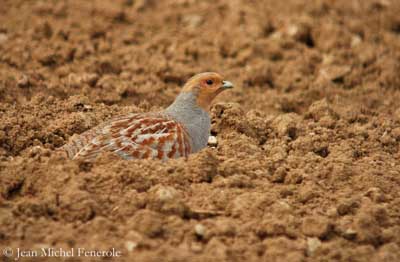
The Grey Partridge is mainly sedentary, but it can be nomadic in bad weather conditions in Europe, and it performs altitudinal movements in some mountainous parts of the range.
FLIGHT:
The Grey Partridge has strong and fast flight on short distances of about two kilometres. Usually, the flight is whirring with frequent glides.
REPRODUCTION:
The breeding season varies according to the range, but generally occurs in spring from late April to June, with a second clutch in late summer.
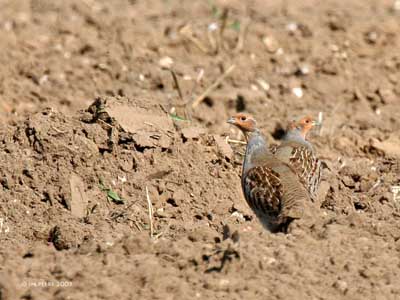
The Grey Partridge is usually monogamous. The pair forms about four months before to breed, and change of mates can be common during this period. Both mates join in the breeding season.
The nest is often placed in dense vegetation, or at base of hedgerow or bush. That is a shallow depression lined with leaves and grass.
The female lays between 15 and 17 olive eggs. Incubation by female alone lasts about 23-25 days, while the male remains in the surroundings of the nest.
The downy chicks have buff upperparts with darker markings, and pale yellow underparts. They are precocial and leave the nest within one hour after hatching. They are cared and protected by both adults.
They are able to make short flights at 10-12 days, but at 16-20 days of age, they fly very well. They still remain with parents for some weeks, and reach their sexual maturity at one year.
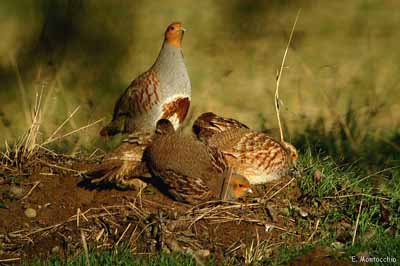
DIET:
The Grey Partridge feeds on seeds of weeds and cereals, and grass leaves. It catches insects such as Coleopteran, aphids and bugs, and Hemiptera, Heteroptera and some larger bugs, beetles and cereal aphids.
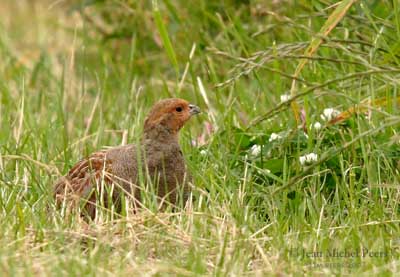
PROTECTION / THREATS / STATUS:
The Grey Partridge is still widespread and the populations are safe. However, declines occur in several parts of the range due to habitat loss with lack of nesting cover, pesticides reducing insect populations, intensification of agriculture practices and hunting pressure. Predation by foxes and feral cats needs to be controlled.
But currently, the species is not threatened.
